Australia So Much to See



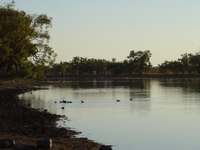
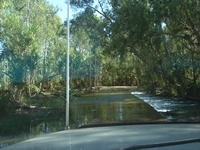
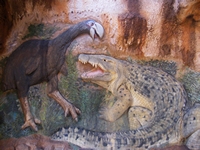
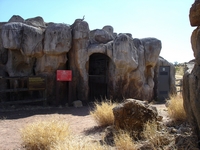
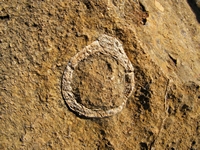
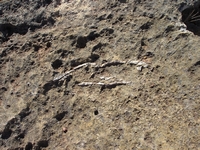
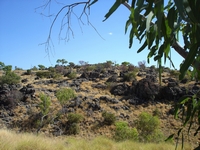
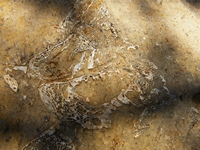
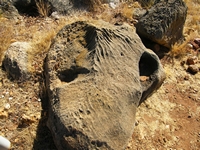
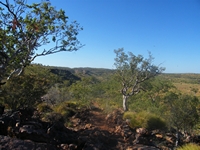
Queensland - We stay by the Billabong at Camooweal, then visit Lawn Hill via the Riversleigh D fossil site
Entering north Queensland, we watch birds at dusk and at dawn whist camped alongside the Camooweal Billabong
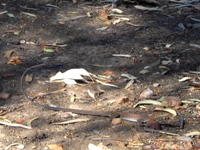
The Camooweal Billabong is on the Georgina River, to the west of the small town of Camooweal. While a large number of campers
gathered not far the road and alongside the dry riverbed, we went much further along the edge of the Billabong and shared a water
view with lots of birds on the water, station cattle coming to drink, a long and slender tailed monitor lizard, and just a few other
caravanners.
After re-fuelling in Camooweal, we headed east for seventy kilometres to take the Yelverton Road north as visiting Lawn Hill was high
on our agenda. This road was bitumised, and the section of the Gregory Downs – Camooweal road we continued on had patches that
were bitumised and some current roadworks. We turned onto the Riversleigh Road which was in good condition. Roads in the
area are mostly well maintained due to mining activity. There were two river crossings on narrow concrete causeways crossing
the O’Shannessy and Gregory Rivers. The water was shallow but fast flowing, with two sections crossing channels of the Gregory River.
Next morning we drove further to the southern end of the lagoon and around to the other side, where the track continued to join to
road to the Camooweal Caves National Park. We returned to the Barkly Highway near the town of Camooweal.
Just after crossing the Gregory River, we noticed a very small six site campground (mostly suitable for tents). The Miyumba
Campground is only four kilometres south of Riversleigh D. There is a pit toilet, and a tank which cannot be guaranteed to have
water and boiling before drinking is recommended. No fires or generators permitted. Bookings must be made and can be done
on line for Miyumba Campground as can the campground in the National Park at Lawn Hill.
We had chosen this route rather than the longer route via Gregory on the advice of staff at Adel’s Grove camping ground that it was
in good condition, and to visit Riversleigh D, part of a site rich in fossils dated at around between 26 million years to current
times. Riversleigh D is the only part open to the public, and a short walk around a hill has rocks with fossils and rocks with
signage about them. Although relatively young fossils, those uncovered from the Riversleigh fossil area are the ancestors of
our modern Australian native fauna, with recognisable large birds, crocodiles, turtles and kangaroos and many more. Almost half
of the knowledge gained so far of Australian mammals over the past 30 million years has come from the discoveries at Riversleigh. Here the first discoveries were made in 1901 with recovery and further discoveries only commencing in 1962. We later learn more
about these fossils with a visit to the Paleontologist who was working within the Mount Isa Visitor Centre at the time. Together
with Naracoorte in South Australia, Riversleigh is a World Heritage Fossil Mammal Site.
On reaching Riversleigh D, the information booth has been made to appear like a large rock and access from the car park is suitable
for wheel chairs. The walk trail around the hill is a dirt path and involves some steps. Guided tours are conducted
from Adel’s Grove.
The property now known as Adels Grove was originally gazetted in 1904 as a Miner’s Homestead Lease. In 1920 Albert de Lestang
took up the property as an experimental Botanical Garden; hence the name "Adel" arose from Albert's initials. By 1939 Albert
had planted over a thousand species of exotic and native plants, shrubs and trees, and supplied the Botanical Gardens of
the world with the seeds produced by his nursery. The Botanical Gardens in Brisbane still has 536 different samples of seeds sent
to them by Albert held in their collection. In the early 1950's a fire swept through the grove while Albert was absent destroying
everything including his dwelling and trunk containing all of his research papers. Albert's last years were spent in a Charters Towers nursing
home, where he died in 1959 at the age of 75.
Reaching the Adel’s Grove campground, we were met by swarms of the large locusts of the type we had met in the Northern Territory. Clouds of them were moving in from the west.
Now a pleasant campground with both old and modern amenities blocks has unpowered sites (some in a generator area) in the Main Campground
and shady camping in the Grove alongside Lawn Hill Creek where the botanical gardens used to be. The creek is suitable for swimming
and kayaking and has a beach. Kayaks can be hired or you can use your own.
We also took a hired canoe along the middle gorge to Indarri Falls. To reach the upper gorge which other travellers highly recommended,
involved dragging the canoe along a sandy track to re-enter the water at the higher level above Indarri. We did not take this
option.
The gorge at the Boodjamulla (Lawn Hill) National Park is an easy ten kilometre drive from Adels Grove. We commenced by
taking the Indarri Falls walk, where a steep climb up a hill has views over the wide stretch of Lawn Hill Creek known as Duwadarri
Waterhole, which the camping area is alongside. The trail then looks over Indarri Falls, where small waterfalls trickle over
a ledge formed from Tufa which holds back the waters of the upper gorge. With a small landing, this is a delightful place to
cool down and swim, and explore the waterfalls. Small fish were in the water around the landing. We returned to the car park
via the flatter route further away from the creek line completing the loop of almost four kilometres. We did not take the seven
kilometre upper gorge walk which continues on from Indarri Falls but is recommended to take early in the morning as it a more challenging
walk.
Near the canoe launch and canoe hire area, the creek divides. This isolates the Island Stack. The main flow of the creek
heads around it to the west, and to the east the watercourse, known as the Old Channels follows around the base of the Stack to join
Lawn Hill Creek again.
Returning from the top of the island stack, we took the short walk to the Cascades where the Tufa formations make the scene look like
a haunted forest. There was a pool where fish nibbled our toes to float in and cool down, with a submerged palm log to sit in
the water and relax. Fish species included young barramundi, striped and spangled bream, archer fish, catfish. There were
also mussel shells in the pool. I got some good ‘bites of barra’ on my toes. We spent quite some time in the water
before we felt cooled enough to walk back to the car park.
Although the Island Stack walk is recommended for early morning only, we decided to brave this in the heat of the middle of the day. I would not recommend taking this walk at this time as it really was too hot. Following a very steep climb up 200 metres, a
1.7 kilometre loop follows around the perimeter of this exposed flat hilltop. We were carrying adequate drinking
water, but the heat was to much.
Another walk we did not take is to the Constance Range which runs parallel to the gorge. This four kilometre walk goes to the
top of the range.
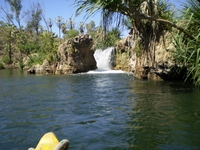
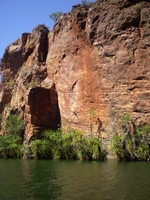
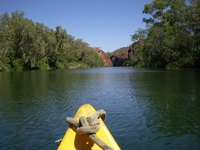
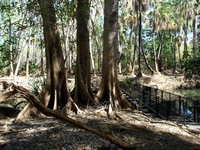
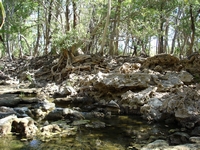
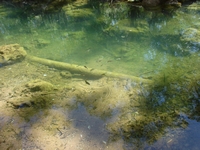
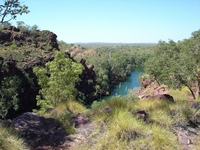
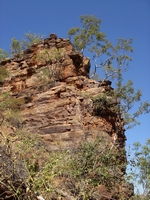
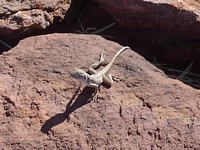
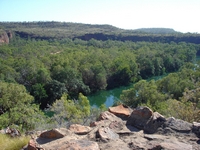
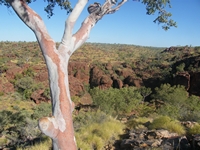
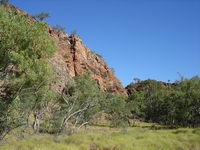
On the dry hilltop, small lizards sunned themselves on the rocks; one local species is known as the Tata Lizard, due to its stance
with hands in the air.
There were panoramic views from each part of the loop walk, as well as some Aboriginal rock paintings; of which photography is not
permitted. There is a further rock gallery site near where the Old Channels rejoin the creek which can be reached by an easy
and shady walk trail that the follows the Old Channels.
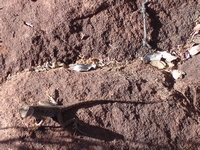
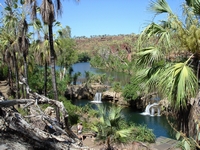
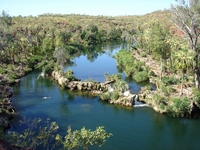
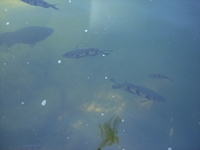
Read more about the pastoral history of the Riversleigh Lawn Hill area and station owner explorer Frank Hann here
Copyright (C) 2013 AustraliaSoMuchtoSee.com. All rights reserved
Camping at Camooweal Billabong is currently CLOSED, until at least December 2023. Reason given for closing the sites for camping
is to protect cultural heritage. Day access will be permitted for Camooweal permanent residents only.
Due to massive
damage caused by flooding, the Boodjamulla National Park (including Lawn Hill Gorge and Miyumba camping areas) and the Riversleigh
World Heritage Area are temporarily CLOSED until Sunday 31 December 2023 inclusive when conditions will be reviewed.
Update July
2024: Boodjamulla National Park
In August 2023, the southern sections of Boodjamulla National Park (Aboriginal Land) Riversleigh
D Site (part of the Australian Fossil Mammal Sites World Heritage Area) and Miyumba camping area were re-opened to the public.
The
main area of the park Lawn Hill Gorge remains closed as recovery efforts continue in this extensively flood-damaged area.
Adel's Grove
Camping Area anticipate re-opening 14th July 2023 with limited facilities following significant flood damage. This is
now open; current July 2024.





























